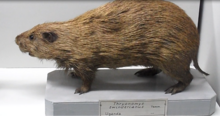Thryonomyidae
| Thryonomyidae | |
|---|---|

| |
| Greater cane rat (Thryonomys swinderianus) | |
| Scientific classification | |
| Domain: | Eukaryota |
| Kingdom: | Animalia |
| Phylum: | Chordata |
| Class: | Mammalia |
| Order: | Rodentia |
| Parvorder: | Phiomorpha |
| Family: | Thryonomyidae Pocock , 1922
|
| Genera | |
|
1 living and many extinct, see text | |
Thryonomyidae is a family of
cane rats (Thryonomys) found throughout sub-Saharan Africa
, and a number of fossil genera.
Taxonomy
Thryonomyidae was formerly more diverse and widespread, with fossil relatives found in
Arabia as well.[1]
The extinct genus Sacaresia from the island of Mallorca off Spain may also be a member of this family,[2] though its position remains uncertain.
- Genus †Epiphiomys
- †Epiphiomys coryndoni
- Genus †Gaudeamus
- †Gaudeamus aegyptius
- Genus †Kochalia
- †Kochalia geespei
- Genus †Monamys
- †Monamys simonsi
- Genus †Neosciuromys
- †Neosciuromys africanus
- Genus †Paraphiomys
- †Paraphiomys afarensis
- †Paraphiomys hopwoodi
- †Paraphiomys knolli
- †Paraphiomys occidentalis
- †Paraphiomys orangeus
- †Paraphiomys pigotti
- †Paraphiomys renelavocati
- †Paraphiomys shipmani
- Genus †Paraulacodus
- †Paraulacodus indicus
- †Paraulacodus johanesi
- Genus †Protohummus
- †Protohummus dango
- Genus †Sacaresia?
- †Sacaresia moyaeponsi
- Genus Thryonomys
- Thryonomys gregorianus
- Thryonomys swinderianus
- †Thryonomys asakomae
Former fossil members of the family include the genus Apodecter and two species of Paraphiomys (australis and roessneri), which have now been transferred to the related Petromuridae.[3]
References
- hdl:10261/44218.
- ISBN 9781119675747.
- .
